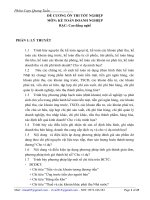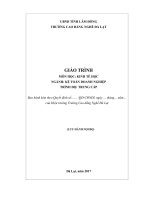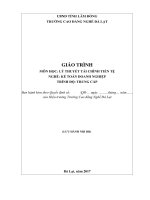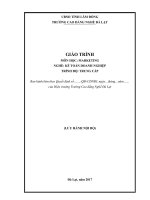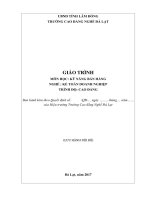Giáo trình Anh văn chuyên ngành Nghề: Kế toán doanh nghiệp (Cao đẳng) CĐ Nghề Đà Lạt
Bạn đang xem bản rút gọn của tài liệu. Xem và tải ngay bản đầy đủ của tài liệu tại đây (4.38 MB, 59 trang )
UBND TỈNH LÂM ĐỒNG
TRƯỜNG CAO ĐẲNG NGHỀ ĐÀ LẠT
GIÁO TRÌNH
MÔN HỌC: ANH VĂN CHUYÊN NGÀNH
NGHỀ: KẾ TOÁN DOANH NGHIỆP
TRÌNH ĐỘ: CAO ĐẲNG
Ban hành kèm theo Quyết định số:
/QĐ-CĐNĐL ngày …tháng.... năm……
của Hiệu trưởng Trường Cao đẳng Nghề Đà Lạt
(LƯU HÀNH NỘI BỘ)
Đà Lạt, năm 2017
TUYÊN BỐ BẢN QUYỀN
Tài liệu này thuộc loại sách giáo trình nên các nguồn thông tin có thể được phép
dùng nguyên bản hoặc trích dùng cho các mục đích về đào tạo và tham khảo.
Mọi mục đích khác mang tính lệch lạc hoặc sử dụng với mục đích kinh doanh
thiếu lành mạnh sẽ bị nghiêm cấm.
i
LỜI GIỚI THIỆU
Vài nét về xuất xứ giáo trình:
Giáo trình này được viết theo Kế hoạch số 1241/KH-CĐNĐL ngày 30 tháng
12 năm 2016 của Trường Cao đẳng nghề Đà Lạt về việc triển khai xây dựng
chương trình đào tạo theo Luật Giáo dục nghề nghiệp để làm tài liệu dạy nghề
trình độ cao đẳng.
Quá trình biên soạn:
Trên cơ sở tham khảo các giáo trình, tài liệu về tiếng Anh trong kinh doanh,
giáo trình này được biên soạn có sự tham gia tích cực của các giáo viên có kinh
nghiệm, cùng với những ý kiến đóng góp quý báu của các chuyên gia về lĩnh vực
hành chính, văn bản.
Mối quan hệ của tài liệu với chương trình, mô đun/môn học:
Căn cứ vào chương trình đào tạo nghề Kế toán Doanh nghiệp cung cấp cho
người học những kiến thức cơ bản tiếng Anh trong Kế toán, từ đó người học có thể
vận dụng những kiến thức này để ứng dụng trong công việc thực tế khi ra trường
Cấu trúc chung của giáo trình Anh văn chuyên ngành gồm 4 chương:
Chương 1: Tổng quan về kế toán
Chương 2:Báo cáo tài chính và các chỉ số
Chương 3: Kế toán thuế
Chương 4:Đơn đặt hàng và Thư điện tử
Sau mỗi chương đều có các bài tập củng cố kiến thức cho người học.
Giáo trình được biên soạn trên cơ sở các văn bản quy định của Nhà nước và
tham khảo nhiều tài liệu liên quan có giá trị. Song chắc hẳn quá trình biên soạn
không tránh khỏi những thiếu sót nhất định. Ban biên soạn mong muốn và thực sự
cảm ơn những ý kiến nhận xét, đánh giá của các chuyên gia, các thầy cô đóng góp
cho việc chỉnh sửa để giáo trình ngày một hoàn thiện hơn.
Lâm Đồng, ngày……tháng……năm………
Chủ biên
Đỗ Trịnh Hoài Dung
i
Mục lục
Chương 1: Tổng quan về kế toán ....................................................... 1
Chương 2:Báo cáo tài chính và các chỉ số .......................................... 14
Chương 3: Kế toán thuế......................................................................26
Chương 4:Đơn đặt hàng và Thư điện tử............................................ 34
i
GIÁO TRÌNH MÔN HỌC ANH VĂN CHUYÊN NGÀNH
i
Tên môn học: Anh văn chuyên ngành
Mã môn học: MH21
- Vị trí, tính chất của môn học:
- Vị trí: Là môn học bắt buộc của nghề Kế toán doanh nghiệp
- Tính chất: Môn học Anh văn chuyên ngành là môn học bắt buộc thuộc chương
trình đào tạo nghề Kế toán doanh nghiệp, được giảng dạy sau môn Anh văn căn
bản, Nguyên lý kế toán, Kế toán doanh nghiệp, giúp cho sinh viên có thể sử dụng
đuợc các thuật ngữ chuyên ngành kế toán, đọc được các báo cáo kế toán bằng tiếng
Anh
- Mục tiêu môn học:
Về kiến thức:
- Trình bày được các thuật ngữ chuyên ngành kế toán, báo cáo kế toán bằng tiếng
Anh
Về kỹ năng:
- Sử dụng được các thuật ngữ chuyên ngành kế toán bằng tiếng anh
- Đọc được các báo cáo kế toán bằng tiếng Anh (bảng cân đối kế toán, báo cáo kết
quả kinh doanh)
Về năng lực tự chủ và trách nhiệm:
- Có khả năng tự nghiên cứu, tự ho ̣c, tham khảo tài liê ̣u liên quan đế n môn ho ̣c để vâ ̣n
du ̣ng vào hoa ̣t động hoc tâ ̣p.
- Vâ ̣n du ̣ng được các kiế n thức tự nghiên cứu, ho ̣c tâ ̣p và kiế n thức, kỹ năng đã được
ho ̣c để hoàn thiê ̣n các kỹ năng liên quan đế n môn ho ̣c mô ̣t cách khoa ho ̣c, đúng quy
đinh.
̣
Chapter 1: Introduction to accounting
Make a list of all the different types of job you know about in accounting
i
1. Here are some jobs and definitions. Fill in the gaps in the definitions with
words from the box below.
specializing • studying • for inspecting its accounts • processing the records •
giving administrative support • to
inspect its accounts
Trainee accountants
Accountants who are ____________
1
for professional examinations
Bookkeepers
Administrative staff responsible for _________
activities
2
of
a
business’s
financial
Tax accountant
An accountant _____________ 3 in a company’s tax affairs
Back-office manager
Person in charge of the staff responsible for _________
department
4
to
the
Finance
Internal auditors
Employees of a company who are responsible _______
5
External auditors
People employed by an outside firm of accountants and hired by a company
______________________
6
AUDIO
1
2 Michael Rogers, a CPA (Certified Public Accountant) from the US is
meeting Paul Martens, the CFO (Chief Financial Officer) of a company in
Belgium. Listen to Michael’s conversation with Mr. Martens’ secretary. Are
there any jobs mentioned which are not included in the activities on the
previous page?
AUDIO
3. Now listen to the meeting. What is the reason for the meeting?
4. Here are some mixed-up phrases from the conversation. Re-order them so
that they make sense.
1. in Mr. moment Martens you with will be a.
2. have Did you a flight nice?
3. coffee Would some you like?
4. keep Sorry you to waiting.
5 come Please in seat take and a.
6 call finishing He’s just phone
7 to nice you meet It’s.
5. Now fill in the gaps with a suitable word from the box.
bad • absolutely • very • know • start • fill • fairly
1. You’re ____________right.
2. Would you like to ________________
experience?
by telling me a little about your
3. I guess you ___________________ that I studied economics in New York.
4. And then I’ll ________________
5. Your C.V is _________________
you in on our group.
impressive.
6. But that’s not a__________________
thing.
7. We’re ____________________international here now.
Listen again to the meeting and check your answer
6. Make two lists. In the first, write down topics, which would be safe to talk
about with a foreign business partner. In the second, write down unsafe
topics. Compare with a partner.
2
i
i
7. Work with a partner to practice greetings and small talk. Look at the
phrases in the box before you go to the Partner Files.
Partner A:
You work in the finance department of your company. Today a new colleague
from your overseas parent company is coming to the office for the first time. (He
or she only speaks English.) You have been asked to welcome the new colleague,
show him/her around the office, and make him/her feel comfortable. At the end
you should introduce your new colleague to the head of the department
Partner B:
It is your first day in your new job as a member of the finance department in one of
your company’s European subsidiaries. You only speak English, but hope to start
learning the local language soon. One of your new colleagues will meet you and
show you around the company. Make small talk and ask questions about the
company. (How many people work there? Do they have a canteen? Does the
company offer language classes? etc.)
Useful Phases
3
Meeting people
Offering hospitality
Helto, Mr/Ms .... I’m ....
It’s nice to meet you.
- (It’s) Nice to meet you, too.
May 1 introduce you to ... ?
I’d like to introduce you to ....
Have you met... ?
Can 1 take your coat?
Please come in and take a seat.
Can 1 get you a cup of coffee/tea?
Would you like something to drink?
-Yes, please./Yes, that would be great.
- No, thank you. / No, thanks.
8. What do the following abbreviations mean? Check your answers in the
article below.
GAAP • IFRS • IAS • IASC
4
i
International accounting
International companies can choose how
from unrealized losses, or to re-
they present financial information to
value long term assets upwards,
outside parties. The rules and regulations
provided sufficient proof of the
between countries vary significantly.
current value can be shown. This
Accountants worldwide are familiar with
means that accounts can have very
the
Accepted
different values, depending on
Accounting Principles (GAAP)’. Some of
whether the company chooses to
the basic principles are:
follow local accounting standards,
words
‘Generally
the going concern
International Financial Reporting
principle
Standards (IFRS) — formerly the
the prudence principle
International
the matching principle
the consistency principle.
The development of these principles has
greatly differed between countries. For
example,
in
most
English-speaking
countries it is often accepted practice to
offset unrealized gains
Accounting
Standards (IAS) - or U.S. GAAP.
Whether the company can choose
is governed by the laws of the
country where it is registered. For
example, the U.S.A. and Japan
currently allow publicly- traded
companies
financial
standards
to
prepare
statements
of
the
using
their
the
International
Accounting Standards Committee
(IASC), but they must also include
reconciliation to domestic GAAP.
5
i
9. Use words from each box to make word partnerships. Then match
them to the definitions below,
outside • accepted • English-speaking • local accounting • publicly-traded
i
company • practice • standards • parties • countries
1. A firm that sells its shares to anyone who wants to buy them.
2. For example, Australia, the U.K., and the U.S.A.
3. The way that most people do something.
4. The rules and regulations which state how accountants operate in a
particular place.
5. People or groups who are not involved with the company.
10.The article mentions four basic principles of accounting. Match them
to the definitions below.
1.
This principle is concerned with the timing of the recognition of transactions
in the accounts. Items are recorded when the income or expense arises, and
are not dependent on the movement of cash.
2.
When preparing accounts, one must assume that the enterprise will still be
viable in the years to come. Practically all-accounting items are affected by
this assumption, such as the carrying value of fixed assets and inventories,
and the ability to repay debts and other obligations.
3.
What value should be given to the numbers in the accounts? It is normal to
act pessimistically, so that profits and assets are not overstated, and expenses
and liabilities realistically valued.
4.
6
Accounts should be produced using the same principles from one year to the
next. Deviations from this principle must be noted, and the effects on the
accounts shown.
11. Do you know of any differences in the application of these principles
between countries? What should a visiting accountant know about the
principles in your country?
Make notes, and prepare to brief someone else in the class.
12. Read this email on creative accounting, and then decide if the
statements below are true or false
1 Accountants agree that creative accounting is a good thing.
7
i
2 Off-balance-sheet accounting is one way of creative accounting - there are
others.
3 Creative accounting is sometimes used to try and attract more investors.
i
4 Accountants are allowed some flexibility in the way they present accounts.
5 Leasing is actually illegal.
6 Big profits mean paying less tax.
7 When a company leases an asset, the accountant doesn’t have to include it
in the accounts.
AUDIO
13. Listen to the conversation between the Managing Director (Charles)
and the Financial Director (Sally). Answer these questions. Make a note
of the words and phrases that helped you to answer.
1 Do Charles and Sally agree that
their company has a debt problem?
2 What are the consequences of the
debt problem?
3 Why do they need a solution to the
problem soon?
4 How does Charles suggest they
deal with it?
5
Has Charles made a final decision about what to do?
6 Do we know whether Sally agrees with Charles’s suggestion?
Fill in the gaps in the extracts from the conversation.
Charles
The shareholders are getting nervous, and the markets don’t like our
level of g________________1. We’re getting more and more
questions about whether we can s__________________ our
d__________________ 2,
in
the
I_______________
3
t______________________
.
It’s getting harder to attract new investments. So I wanted to speak to
you about what we can do. We’re investing a s_________________
4
amount in our new factory in Germany so we need to
c_________________ u________________ w__________________
5
a solution soon. The new factory is very important, and we’re
looking at leasing the assets.
Sally
You’re thinking that if we I _____________ the a _______ 6, we can
8
exclude these l ______ ______ 7 from the balance sheet?
Charles
Exactly.
Sally
You know that the auditors will look very closely at these
transactions? The accounting s
_____________ 8, or principles
if you like, mean that finance leases must be d__________________ 9.
If we are effectively _______________ 10.
Now listen again and check your answers.
15. Use liability, liabilities, debt, or debts to complete the sentences below
9
i
i
1. He’ll have paid his_____________ off by next
year.
2. Look at the assets and____________
on the
balance sheet if you want to know how the company’s doing.
3. Many developing countries are burdened by heavy
.
4. We need to look at the long-term
_________ before we think about any
major new purchases.
5. The partnership has limited_______ status
6
Current ________ are those which are paid off within a year.
7
The company’s in _____ to the tune of 10 million.
Now listen and check your answers
10
16 In the conversation in exercise 11, Sally agrees with Charles. Here are
some other ways to agree or disagree with someone. Put a tick (✓ V) next to
the ones which mean agreement, and a cross (X) next to those which mean
disagreement.
1 You’ve got a point there.
5
It’s just not on.
2 I see what you mean.
6
Fair enough.
3 Me neither.
7
Point taken
4 No way.
17 Now use the above expressions to respond to the following statements. Note
that more than one answer is possible.
Do you agree with the speaker? Use the phrases above to agree or disagree and
continue the discussion with a partner.
11
i
i
Becoming an accountant
CPA
The body which represents the interests of accountants in the U.S. is the American
Institute of Certified Public Accountants (AICPA). To become a CPA, the
applicant must meet the requirements of the state where he/she wishes to practise,
as established by the law of that state and administered by the state boards of
accountancy.
To qualify for certification, the applicant must:
1
study accountancy at a college or university
2
pass the CPA examination, which consists of four sections:
•
Business Law and Professional Responsibilities
•
Auditing
Accounting and Reporting-Taxation, Managerial, and Governmental
and Not-for-Profit Organizations
•
•
Financial Accounting and Reporting - Business Enterprises
3
have professional work experience in public accounting.
Most states require a qualified CPA to carry out regular professional
training.
Chartered Accountant
The major accounting body in the U.K. is the Institute of Chartered Accountants
in England and Wales (ICAEW).
To become a Chartered Accountant, the applicant must:
12
1
2
have sufficient school or university education
apply for a training contract with a recognized company, which will give him/her
three years’ work experience
3
pass the ICAEW’s exams on:
•
Accounting
•
Audit and Assurance
•
Business Finance
•
Business Management
•
Financial Reporting
•
Taxation
4
as well as prove his/her knowledge on Commercial and Company Law, and then
with further exams on:
•
Business Environment
•
Business Life Cycle
•
Advanced Case Study
Over To You
How does the process of becoming an accountant in your country compare to those
described above?
Describe the general accounting rules and practices in your country. What
standards are used to prepare financial information? How is off-balance-sheet
accounting treated in your country? How is leasing reported in accounts?
13
i
Chapter 2:Financial statements and ratios
i
1 Here are two typical examples of the disclosures required under U.S. law. In
the U.K. one would be called a Balance Sheet, and the other a Profit and Lost
Statement In the U.S. they have other names. Which is which?
14
i
2. Match the words with their partners, and then look at the statements again
to check
15
i
Now match the word partners to their definitions.
a An asset which does not have a physical nature (such as a trademark or a
patent).
b The holding company owns a minority interest (less than 50%), but the
accounts are nevertheless consolidated.
c The total legal obligations of a company to pay other parties.
d The ordinary shares held by the owners, who therefore are the last to receive
their money back in the event of liquidation.
e Amounts that will be collected in the normal course of business within one
year.
f Profit which is not paid out to shareholders in the form of dividends, but
instead is kept by the company to reinvest or pay off debts.
g The amounts affecting common stockholders, but not from movements in
the stock of the company (e.g. currency translation adjustments).
3. Compare the financial statements on pages 16 and 17 to ones from your
country. Make some notes for a colleague in the U.S., summarizing the
major differences in the layout.
DID YOU KNOW?
The U.K. and the U.S.A. often have different terms for the same thing. Here
are some important examples. Can you think of any others?
U.K.
U.S.A.
Your language
Balance Sheet
Statement of Financial Position
Profit and Loss Statement
Statement of Earnings
Shareholder
stockholder
16
stock
inventory
gearing
leverage
i
Choose the best way to say these numbers and equations. (Sometimes more
than one way is possible.)
Now listen and check your answers.
DID YOU KNOW?
17
i
3 . Work with a partner to check on some figures. Use the information in your
Partner File to make a phone call.
Partner A: You’re in trouble. You’ve just spilt coffee all over this document, and
you need it for an important meeting in a few minutes. Phone your colleague
(Partner B) and ask him/her to give you the missing numbers.
18
i
Partner B: The following document has just been faxed to you, but some of the
information has not printed properly. Unfortunately you need all the information in
order to brief your boss. You are just wondering what to do when your phone rings
19
